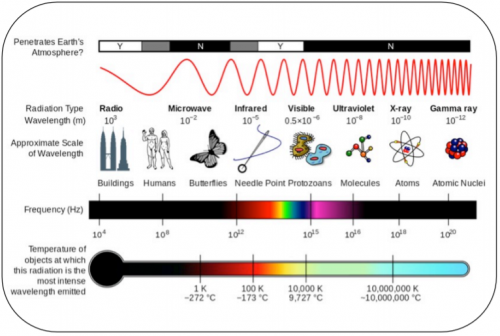Electromagnetic Spectrum
Light as Waves
Physicists describe light as something called electromagnetic radiation or electromagnetic wave [1]. The word radiation means ‘energy that is transported from one spot to another without need of direct contact between the two locations’. Light in each of these colors carries a different amount of energy: gamma rays are the most energetic, and radio is the least. Thus, when we observe gamma or X-rays from an astronomical object, we know that something really powerful is happening there. This energy is transported in the form of a wave, and each color is related to a different wave size: The more energy the wave carries, the narrower it is –or, in technical terms, the shorter its wavelength. Hence, X-rays have shorter wavelengths than visible-light waves, and visible light has shorter wavelengths than radio waves.
Properties of Waves
A wave is a periodic perturbation from an undisturbed or rest state that is transmitted in space. The maximum deviation from this undisturbed state is called the amplitude of the wave, and is a measure of the intensity of the perturbation; the top of the wave is called a crest and the lowest state, a trough. Waves are characterized by their size, measured as the distance between two equal states; this distance is called the wavelength, [math]\displaystyle{ \lambda }[/math]. The colors of visible light are the way our eyes perceive the different wavelengths. The time it takes for the perturbation to move one wavelength –in other words, to repeat itself–, is called the period of the wave, [math]\displaystyle{ P }[/math]. Wavelength and period are related through the speed of the wave, [math]\displaystyle{ c }[/math] [math]\displaystyle{ (≈3*10^8 m/s) }[/math], because speed is defined as space travelled per unit time:
[math]\displaystyle{ c = \frac{\lambda}{P} }[/math]
The number of complete cycles –the number of times the wave repeats itself– in one second is called the frequency of the wave, [math]\displaystyle{ f }[/math]. Thus, the frequency is the inverse of the period, and is also related to the wavelength through the wave speed:
[math]\displaystyle{ f = \frac{1}{P} = \frac{c}{\lambda} }[/math]
It is important to note that the speed of light waves does not depend on the frequency, wavelength or period, but only on the medium the wave is traveling through. However, contrary to other waves like sound or water waves, electromagnetic waves (light) do not actually require a medium to be transmitted through: they can travel through the vacuum. If light travels through a vacuum, it has the maximum possible speed –and this speed is the same for all frequencies of light.
References
- ↑ CESAR. (n.d.). The electromagnetic spectrum Cesar's Booklets.

